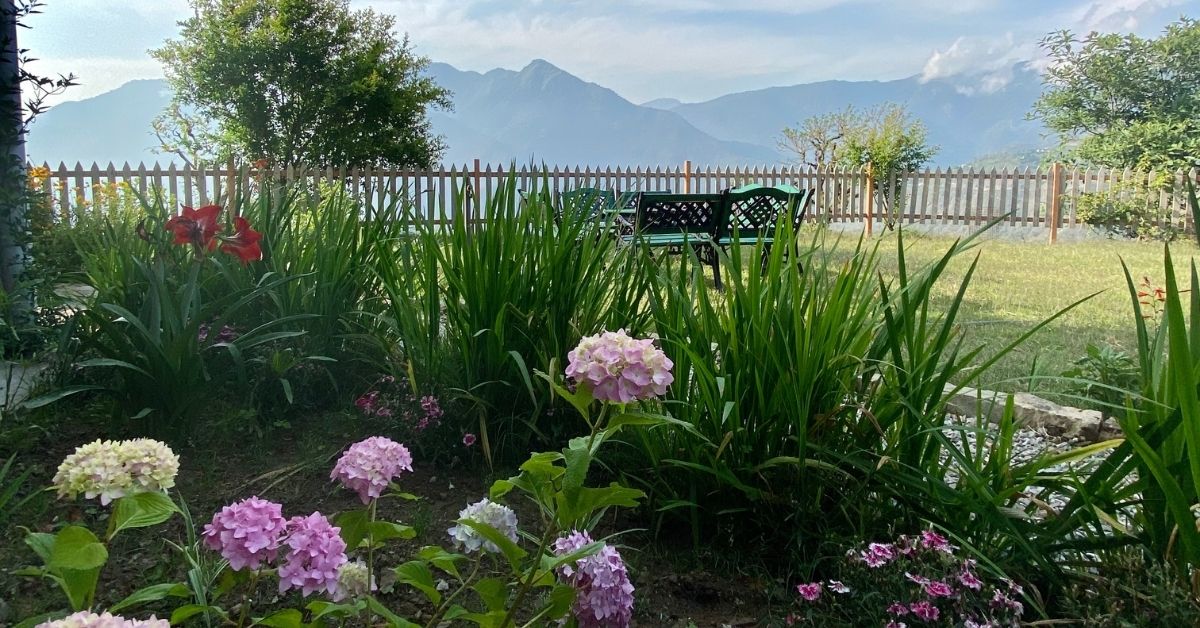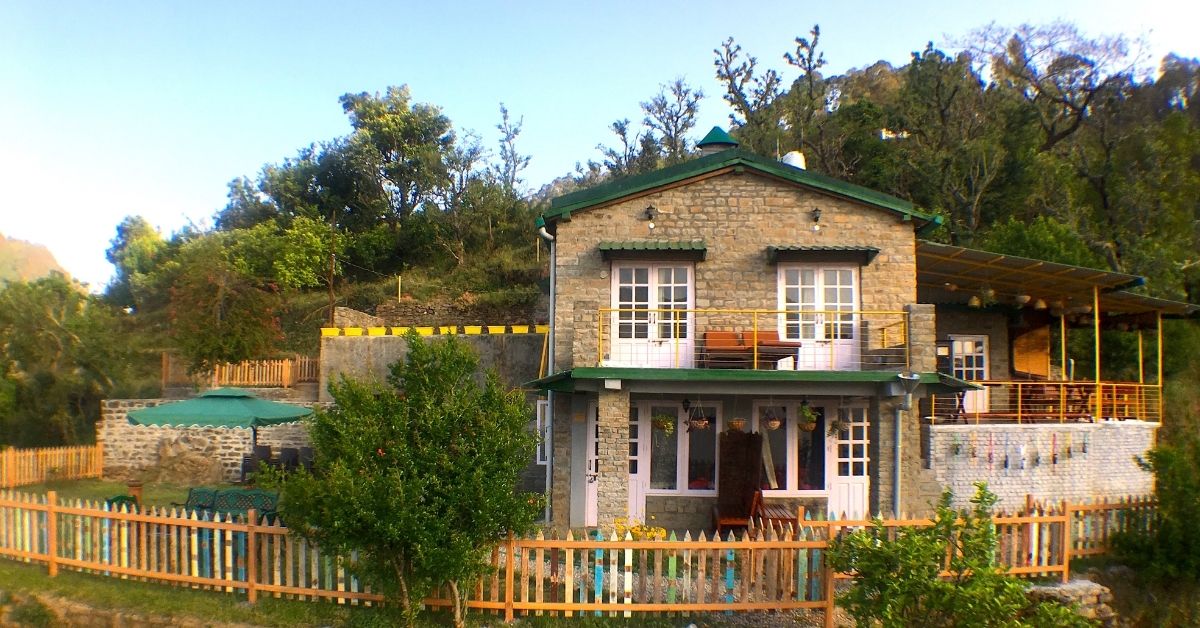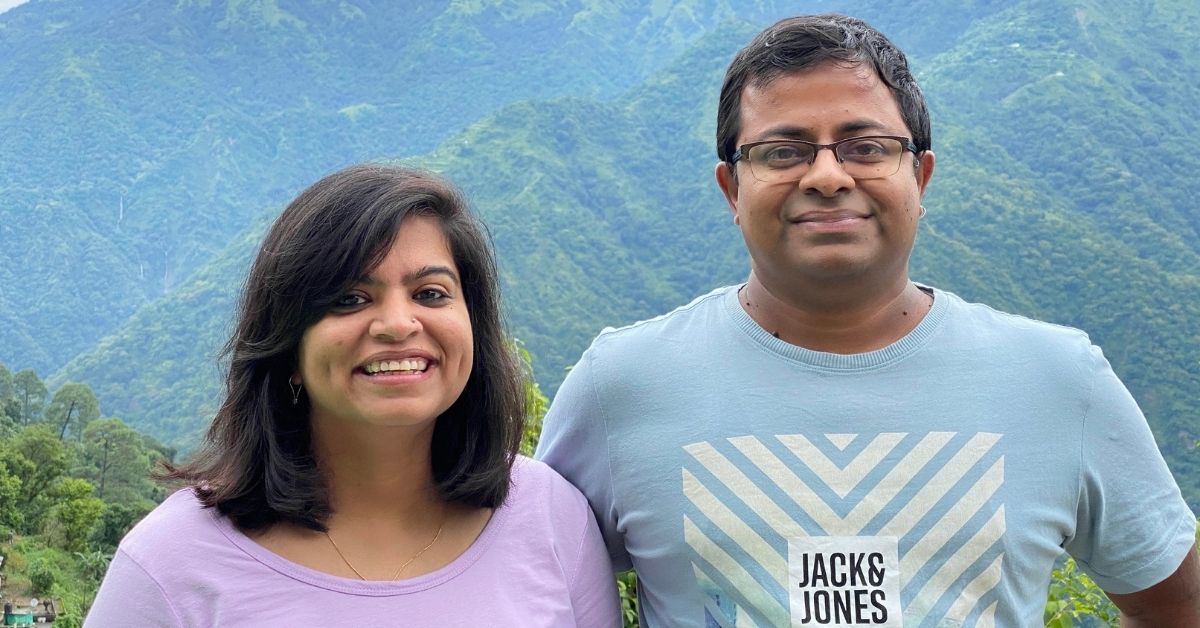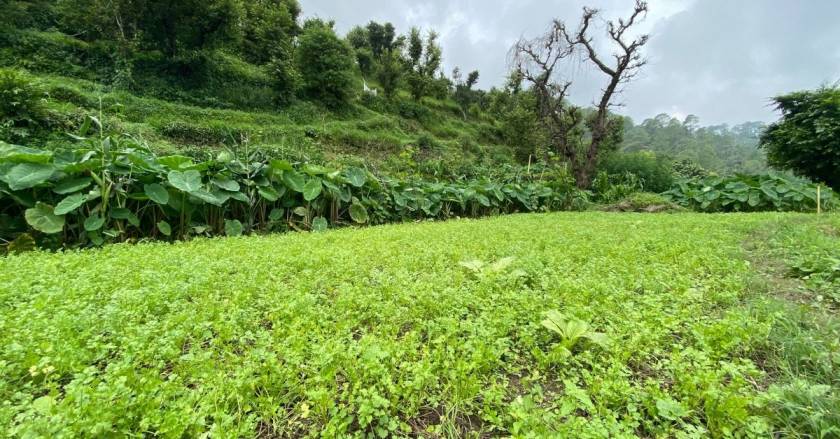Delhi Couple Quit City Life To Build a Dreamy Green Homestay That’ll Last 100 Years
Run by Aditi Pokhriyal and Anil Cherukupalli, Fagunia Farmstay in Uttarakhand brings together traditional Kumaoni architecture with sustainable lifestyle practices like solar power, organic farming and waste management.

Nestled in the lap of Kumaon foothills in Uttarakhand’s Faguniakhet region, at a height of 5,000 feet, the picturesque location of Fagunia Farmstay looks like a scene straight out of a movie. The 3-storey house is surrounded by a dense forest, a seasonal waterfall and offers a view of the Pangot and Nainital mountains.
But there’s more to this house than what meets the eye. It is built using traditional Kumaon architectural practices that are environment-friendly and earthquake-resistant. Just like every Kumaon structure, this one too is built using stone and wood in a way that keeps the house thermally insulated.
The house is built and owned by Anil Cherukupalli and his wife, Aditi Pokhriyal. The Delhi couple quit city life to embrace a sustainable way of living in 2018. As they did not have an architecture degree or prior experience in construction so they researched for months and collaborated with local masons to translate their dream into reality.

Apart from being avid travellers, the duo has a significant amount of experience working in the environmental sector. They have worked at the World Wide Fund for Nature and NGOs working towards the conservation of wildlife and ecosystem.
“Our jobs influenced our thinking and prompted us to adopt a minimalist lifestyle. It was love at first sight with this property, which had a small house and a farm. We wanted to create a space for guests who can come here to unwind. So we used the foundation of the existing house to build our farm stay,” Anil tells The Better India.
He adds, “Due to primary building materials, the house will last for a century or more. During construction, we followed the already existing contours of our site to minimise building pressure on the mountain slopes, which will further help in increasing the longevity of our homestay. No trees or new mountain slopes had to be cut or cleared in this process.”

Balancing a hectic job in Delhi while instructing the local contractor to build the Kumaon-style house without generating a big carbon footprint was not easy. It took nearly two years to create this majestic place.
Kumaon Architecture & Other Eco-friendly Practices

The indigenous architectural style uses local resources of the Himalayan landscape like stone and wood as the main construction material for walls and roofing. A small proportion of cement was used as the primary bonding material for the foundation work.
“More than 70 per cent of the stone and wood was recycled and upcycled from the pre-existing house at the site. The two materials retain warmth and reduce the energy used for heating. Windows form an integral part of the design and are built in a way that allows for plenty of natural light. The two-foot thick stone walls also help in keeping the house cool in summers and warm in winters. As we are in a mountainous location with cold weather that prevails for most of the year, our homestay rooms are compact just like every Kumaon house to keep it cosy,” says Aditi. Additionally, most of the interior has repurposed furniture like tables, chairs and a bookshelf.

The couple did not restrict their sustainable practices to the construction process. They installed a solar power backup inverter system that generates 5-8 units daily along with a centralised solar water heating system for the bathrooms.
The greywater is channelled to the soak pit which has multiple filtering layers of gravel and sand. It eventually percolates below the ground to replenish the water tables. Meanwhile, the black water or sewage is converted into fertiliser with the help of a twin pit toilet system. The wet waste of the household is converted into compost and the plastic waste is burnt safely in an enclosed incinerator.

The natural fertilisers are used to grow organic food like turmeric, ginger, cucumber, zucchini, capsicum, brinjals, among other vegetables. Recently, they have started growing buckwheat and will soon shift to millet-based farming. To further the cause of sustainability, the couple is currently working towards implementing permaculture farming in their plot.
Though the couple reiterates that they have a long road ahead to become 100 per cent self-sufficient and a zero-waste generating farm stay, Anil adds, “We are focussing on implementing small steps to achieve a big target.”
Edited by Yoshita Rao
If you found our stories insightful, informative, or even just enjoyable, we invite you to consider making a voluntary payment to support the work we do at The Better India. Your contribution helps us continue producing quality content that educates, inspires, and drives positive change.
Choose one of the payment options below for your contribution-
By paying for the stories you value, you directly contribute to sustaining our efforts focused on making a difference in the world. Together, let’s ensure that impactful stories continue to be told and shared, enriching lives and communities alike.
Thank you for your support. Here are some frequently asked questions you might find helpful to know why you are contributing?


This story made me
-
97
-
121
-
89
-
167













